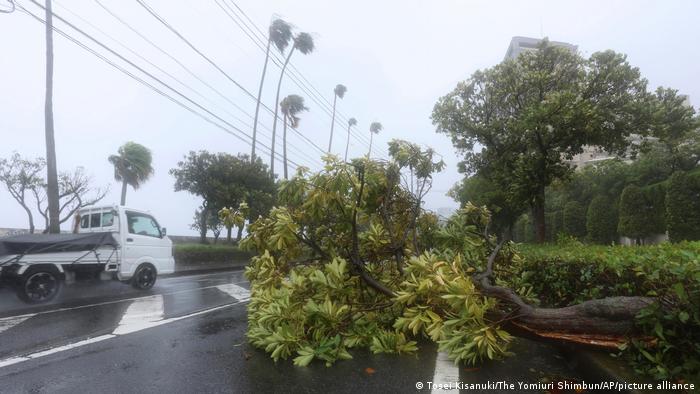
Southern Japan was bracing for "super typhoon" Nanmadol as strong winds and heavy rains battered the region on Sunday.
Thousands of people were evacuated, and the Japan's Meteorological Agency (JMA) warned of unprecedented conditions while the typhoon was passing by remote Yakushima island.
Nanmadol was moving north toward Japan's main southern island of Kyushu, where it was forecast to make landfall later on Sunday.
"Please stay away from dangerous places, and please evacuate if you feel even the slightest hint of danger," Prime Minister Fumio Kishida said after convening a government meeting on the typhoon.
"It will be dangerous to evacuate at night. Please move to safety while it's still light outside," he added.
Meanwhile, authorities issued a tsunami warning for Okinawa, Japan's southernmost and westernmost prefecture, after a strong earthquake hit Taiwan.
How has Typhoon Nanmadol affected Kyushu?
The JMA issued a rare "special warning" for Kyushu's Kagoshima and Miyazaki regions. Japanese authorities only issue such alert for forecast conditions only seen once in several decades.
"The southern part of the Kyushu region may see the sort of violent wind, high waves and high tides that have never been experienced before," the JMA said Sunday, urging residents to exercise "the highest caution possible."
More than 4,700 people in Miyazaki were evacuated, while in neighboring, hard-hit Kagoshima, more than 9,000 residents took shelter at evacuation centers on Sunday.
Some 93,000 homes across the southern island were without electricity due to damage to power lines and facilities, according to Kyushu Electric Power company.
The conditions have also paralyzed travel, with hundreds of domestic flights in and out of the region canceled. Flights are also planned to be grounded in western Japan through Tuesday as the typhoon heads northeast, Japan Airlines said.
Public transportation has also been suspended throughout Sunday in Kagoshima and Miyazaki.
What is the forecast for Typhoon Nanmadol?
The JMA expects Kyushu to receive 50 centimeters (20 inches) of rain and wind gusts of up to 250 kilometers (155 miles) per hour on Sunday.
The central Tokai region could have 30 centimeters of rain.
By Wednesday, Nanmadol is forecast to have moved out to sea after passing over Japan's main island of Honshu.
It has already brought heavy rains to Tokyo, causing the suspension of some subway lines.
Japan and extreme weather
Nanmadol is the 14th typhoon of the season.
Japan routinely sees heavy rains that trigger landslides or flashfloods in typhoon seasons. But scientists warn that climate change heightens the intensity of such weather conditions.
In 2019, more than 100 people died as Typhoon Hagibis pounded Japan as it hosted the Rugby World Cup.
A year earlier, at least 200 people were killed in western Japan during the annual rainy season.